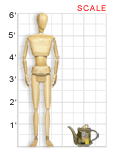VAM galleries including this work:
Kentucky Museum of Art and Craft | How’d They Do That? || VAM Home
Wayne Ferguson (Kentucky, b. 1946)
TEA SET, 2004
Glazed stoneware; 12" X 9"
Kentucky Museum of Art and Craft
This piece by Wayne Ferguson is an example of a functional tea set. It was made to be used, and to look great, too!
About the Artist
Wayne Ferguson recalls playing with clay that his mother mixed from flour, salt, and food coloring while he was growing up in Whitley County, Kentucky. That was Wayne’s first taste of the medium, and he hasn’t stopped working with clay since.
Ferguson refined his artistic ability as a student at the University of Kentucky, where he was able to experiment with a variety of pottery techniques. Over the past 30 years, he has developed one of the most distinctive styles among Kentucky ceramic artists with his trademark sense of humor and whimsical animal forms. His ceramic whistles are favorites with collectors, and he often adds whistles to his other works.
“Clay enables me to create entities which communicate or tell stories.”
Pottery is a vehicle of communication for Ferguson. He often uses his work to express his reactions to external influences, which range from issues of unsatisfactory AIDS education and environmental concerns to the simple act of catching a fish. Clay “enables me to create entities which communicate or tell stories,” he says. “As an artist, the communication factor is important.” Ferguson shares his knowledge, skills, and enthusiasm for ceramic arts with students of all ages and abilities.
Note: Wayne Ferguson discusses his work in the Visual Arts Toolkit video segment “Ceramics: Wayne Ferguson” on Through Artists’ Eyes: Exploring the Creative Process. He also is featured in the video segment “The Artist’s Point of View, Part 2” on Responding to Visual Art.
Classroom Ideas
Discussion: Describe this tea set. How did the artist use the elements of art in the pieces? What is your opinion of the work? Use specific details that reference the artwork in your response. Does this look like other tea sets you have seen? How is it similar? How is it unique?
Activities: The tea ceremony is a very intricate and important ritual in Japan. Visit the web site listed under links to learn more about the ceremony, known as chaji. Then create a ceramic teacup and have a tea ceremony in your classroom.
Directions:
- Using clay, roll out a slab about 1/2 inch thick. Then trim the slab into a rectangle that is about 5" X 10". Use a cardboard roll about the size of a toilet-paper roll as an armature to roll the clay around.
- Roll out a “hamburger patty” about 1 inch thick. Trace the bottom of the roll, leaving about 1/4 inch around the circumference. Remove the excess clay outside the tracing to leave a round shape.
- Attach the round shape to the bottom of the cylinder shape and smooth out the cup. If you have time, add a foot to it for a more traditional teacup look.
- Decorate the cup with images from nature.
- After the clay has been bisque-fired, use a lead-free glaze to glaze it, then fire it again.
- Now use the teacup in your tea ceremony!
Links
Learn more about the Japanese tea ceremony at the Holy Mountain web site. The site also includes images of Japanese teapots.
[www.holymtn.com/tea/Japanesetea.htm]
Browse a collection of artistic teapots at the Trenton Teapot Museum.
[www.teapotcollection.com]


